HARVESTING of the second and final rice crop for 2014 has been completed for the most part, bringing in approximately 312,000 tonnes of rice to date and testifying to another record for the industry, following production of over 300,000 tonnes in the first crop.

Head of the Guyana Rice Producers’ Association (RPA), Dharamkumar Seeraj, told the Guyana Chronicle that some 480,000 tonnes of paddy were harvested across the rice-producing regions.
“All the regions have completed harvesting, with the exception of about 800 acres in Region 5 (Mahaica/Berbice),” he said.
Rice production had been at its lowest levels in Guyana in the late 1980s because of the neglect the industry had to endure through lack of sound agricultural policies and programmes and little or no investment in agricultural infrastructure and research, and training. Today, there are greater investments in agricultural infrastructure, education and training of farmers, and in research, and there are more guaranteed markets as well.
Secure drainage, new and improved farming technologies, and new rice varieties are among some of the interventions made over the years by Government. Those interventions have been fuelling the rice industry’s growth.
Government has also moved to secure several markets for rice farmers, the largest being Venezuela.
Government, cognisant of maintaining the strong performance of the rice industry, had set aside in the 2014 Budget the sum of $500M to help maintain its competitiveness.
The industry will also benefit from this year’s investment in drainage and irrigation.
MOSTLY UNAFFECTED
Seeraj said the rains have not affected the rice crop, given that rice farmers are currently preparing lands for the first crop of 2015.
“There is some accumulation of water in some areas, but because we are in the land-preparation period, we need water to continue land preparation and for sowing,” Seeraj said.
He added that some areas in Region 2 (Pomeroon/Supenaam) have seen some water accumulation, while Region 3 (West Demerara/Essequibo Islands) has been unaffected by the rains, and Region 4 (Demerara/Mahaica) has had some flooding, particularly in the Cane Grove community.
“Cane Grove farmers saw about 9.6 inches (of rainfall), which is 244 millimetres of rain; and that caused some flooding, but the rice crop was not affected,” Seeraj said.
The RPA head noted that Region 5 is one of the regions where there was some water accumulation, but the region needs more rain, because rice farmers are engaged in land preparation.
“Region 6 (East Berbice, Corentyne) also needs more rain, because the preparation for 2015 has started,” he said.
Asked about yields, Seeraj said rice farmers have been enjoying good yields – between 4.2 and 6.3 tonnes per hectare.
The other sore point of payments was also addressed, and he noted that there are some complaints about delayed payments in Regions 2, 3 and 5.
“Because of the size of the harvest, we are seeing that there are some delayed payments. While the exports of rice are breaking records, the fact is, given the volume, the production is large,” Seeraj said.
EXPORTS CONTINUE
He also disclosed that exports continue on schedule, even as the sector’s stakeholders are pursuing even more markets.
“We have exported rice to Panama, Venezuela, several Caribbean countries and Europe,” the RPA head said.
The trend over the last few years has been one of increasing rice production. Seeraj explained that Guyana could export all its rice at lower prices, but local exporters have opted to export their rice to markets with better prices.
“We can sell all our rice, but at low prices; so our exporters, because there is the demand, opt to go to different markets,” he said.
The export mark of 400,000 tonnes was surpassed in mid-October, excluding a number of contracts for rice exports that still had to be met.
Five hundred thousand tonnes was the 2020 target for production. However, in 2011, for the first time, the 400,000-tonne mark was passed, and (this) was repeated in 2012 and 2013.
It is expected that Guyana will someday overcome all obstacles and compete with the world’s largest producers of rice. As such, focus is being placed on exploring new and emerging global markets, and on tackling the crucial and critical issues to facilitate increasing production.
The production for 2013 was 535,212 tonnes, which was far above the original target of 413,000, and reflected a 27 per cent increase over production in 2012. The average production per hectare was some five tonnes.
For 2014, production is expected to surpass last year’s target.
(Vanessa Narine)




.png)









